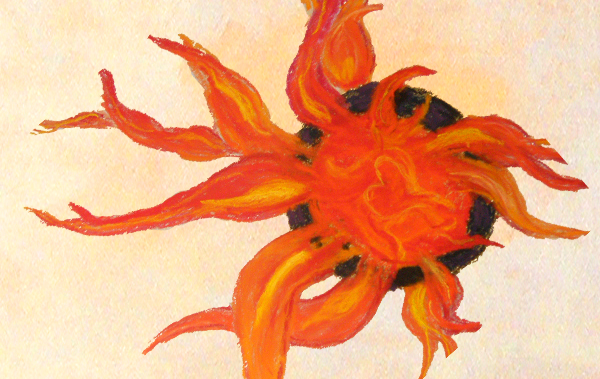Happiness

This painting, called “Break on Through,” was inspired by the flaming pink tennis shoes my acupuncturist's assistant was wearing one day. She's a cheerful, 60-something grandmother who knows how to express happiness! I recalled the lyrics of the song by The Doors; “Break on through to the other side.” For me the painting is about happiness bursting through the barrier of fear, darkness, depression, hopelessness, and repression. For many people, myself included, allowing ourselves to feel happy is a conscious choice, and a lifelong process of opening up and letting go of a sense we got from family and culture that it’s not okay to be happy. And many of us who feel deeply the suffering and pain of the world often do not think it’s okay to be happy.
Ram Dass asks, “Does knowing the sorrow of the world mean that we don't throw the Frisbee on the beach?" My answer to that question is that we both grieve for the pain of the world and we express the joy of being alive in an amazing and beautiful place.
So what makes you happy? What makes your heart dance and burst with joy? Think about one thing that makes your heart smile and then go a little deeper and ask why this makes you happy. For instance, it makes me happy when my dog lies on my lap (even though he’s 65 lbs. we have an arrangement that doesn’t totally squash my innards). It makes me happy to hang out with a being I love. In that deeper place it’s about connection, a sense of oneness with another.
In all the instances that I can think of I find the root of my happiness has to do with a deep connection with my self, with another, or with God. It has to do with living out the meaning and purpose for my being here on the planet. It is about revealing what is deepest within me that wants to be shared. It’s about seeing something good or beautiful or valuable in any moment.
Beloved Buddhist teacher Thich Nhat Hanh says, “Happiness is not an individual matter; it has the nature of interbeing. When you are able to make one friend smile, her happiness will nourish you also.” He urges us to “water the seeds of joy and happiness that lie deep in our consciousness.” He suggests aspirations such as “May I know how to nourish the seeds of joy and happiness in myself (and others) every day.”
I’ll be happy if only . . .
Fr. Richard Rohr says, “Happiness is an inside job.” I agree with this. Yet in our modern consumer culture we are led to believe that it is stuff and outer circumstances that will make us happy. We look for happiness in all the wrong places. Fr. Thomas Keating says we need to change the direction in which we are looking for happiness because some of what we do in pursuit of happiness is based on the need for security, acceptance and approval, power and control. We may find brief bursts of happiness, but how long does that last?
We need to look deeply at our own programs for happiness, and dismantle the thoughts and beliefs that will never make us happy. But (and this is big) we also need to acknowledge that the consumer culture in which we live breeds, and feeds on, our feeling dissatisfied with who we are and what we have. Through incessant advertising we are made to feel we are not attractive enough, not successful or rich enough. We come to feel inadequate, inept, and not okay as we are. So we work harder, and buy more stuff, to feel better about ourselves and our lives.
What we don’t get is that the economic system is designed this way so that the economy will continue to grow, and a small number of people will profit handsomely. We have been led to believe that the economy has to grow in order for things to be okay. But is this true? What about “sustainable” happiness? What about a sustainable economy? Sarah van Gelder, Editor for YES! magazine, has written a fantastic article entitled “A Brief History of Happiness: How America Lost Track of the Good Life—and Where to Find It Now.” She and others (notably Helena Norberg-Hodge, co-founder of Local Futures) really bring to light the direct correlation between our growth economy and our personal happiness. Both of these authors identify and analyze the problem, and point to the solutions. If we don’t realize that much of our unhappiness is the consequence of an economic system that keeps us dissatisfied, we are apt to blame ourselves for things not going well for us. But the system is based on a dog-eat-dog scramble for more money and stuff where there are only a few winners and millions of losers. Many are now realizing that most people and the planet itself are the big losers.
With self-awareness, with the understanding of our interbeingness, and with compassionate action, we can create a world that works for all.
May these resources be informative and contribute to your happiness!
“A Brief History of Happiness; How America Lost Track of the Good Life—and Where to Find It Now,”
"Climate Change or System Change?"
"Making a Difference Makes You Happy"
"Finding Happiness; 11 Simple Ways to Get Your Smile Back
"The 7-Step Morning Ritual That Will Make You Happy All Day"
Sustainable Happiness: Live Simply, Live Well, Make a Difference, Edited by Sarah van Gelder and the Staff of Yes! magazine.
Back to Blog